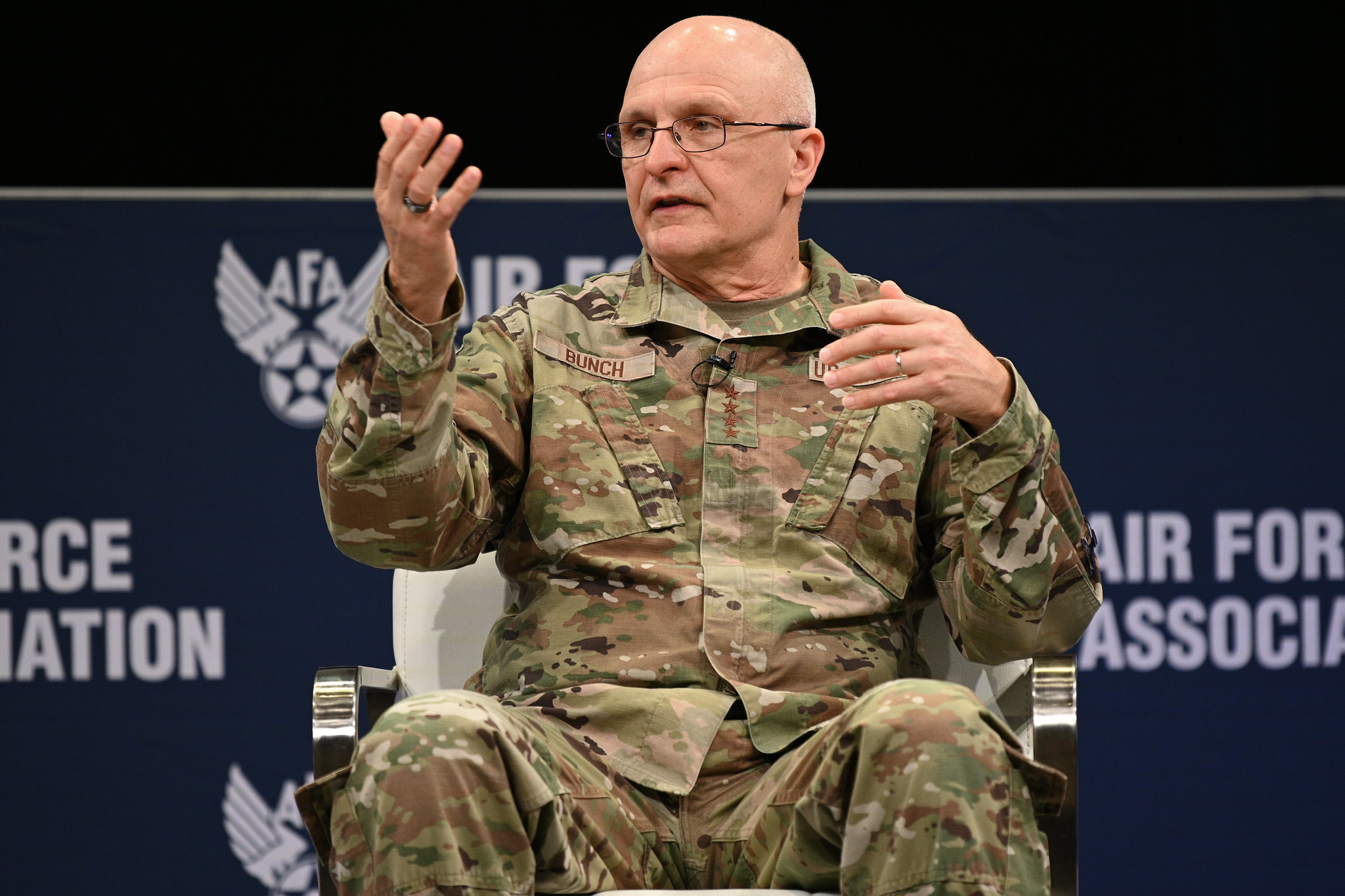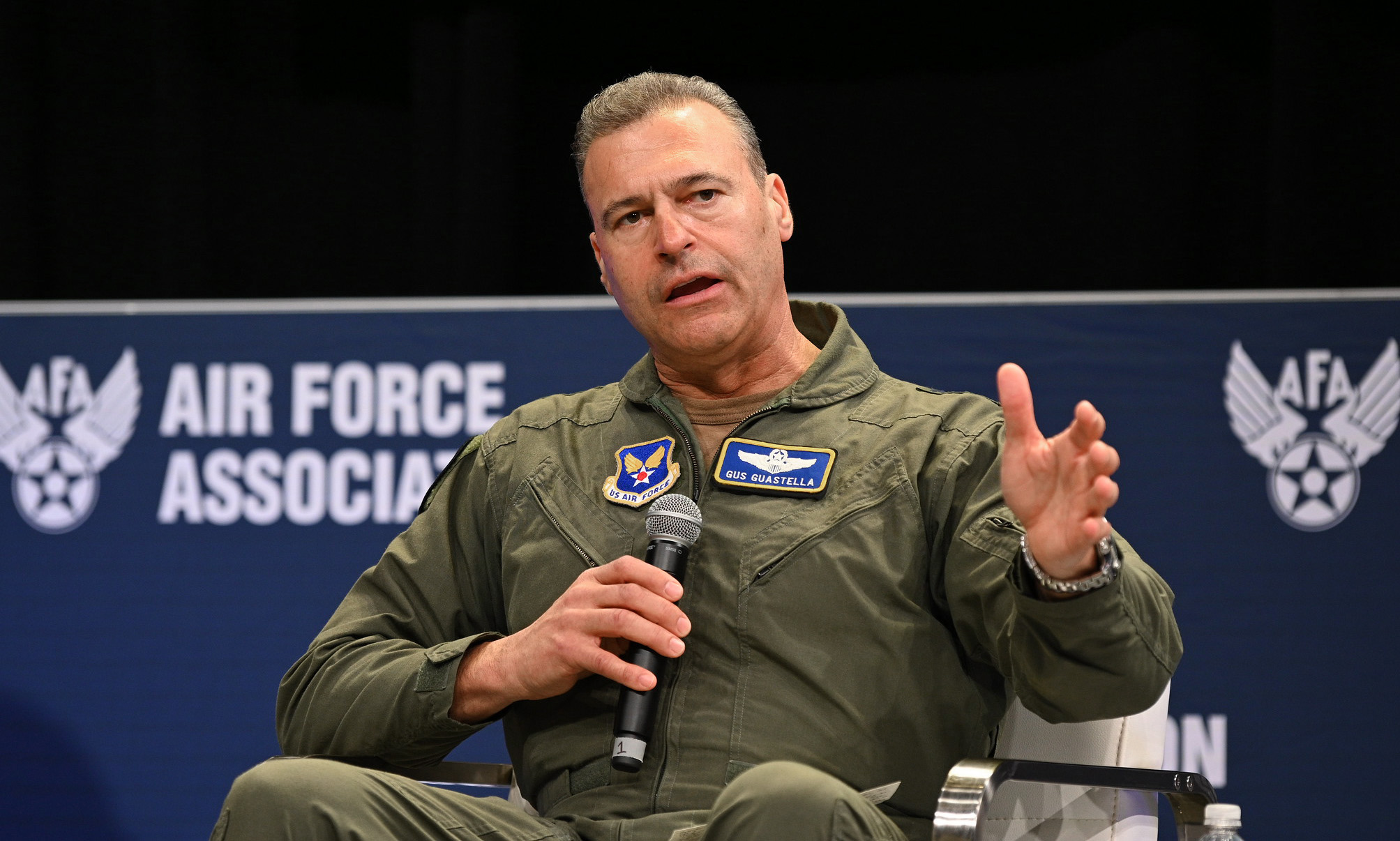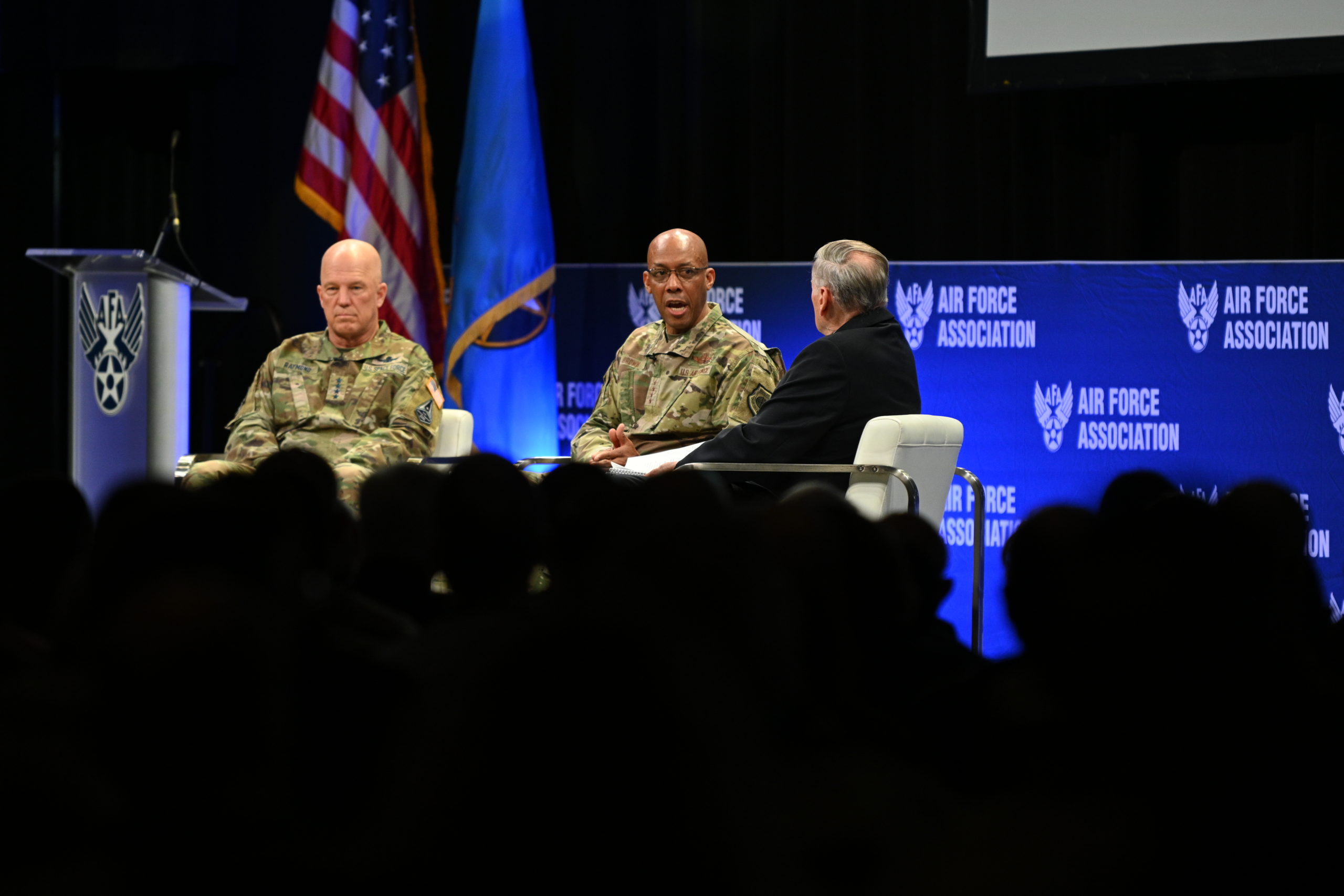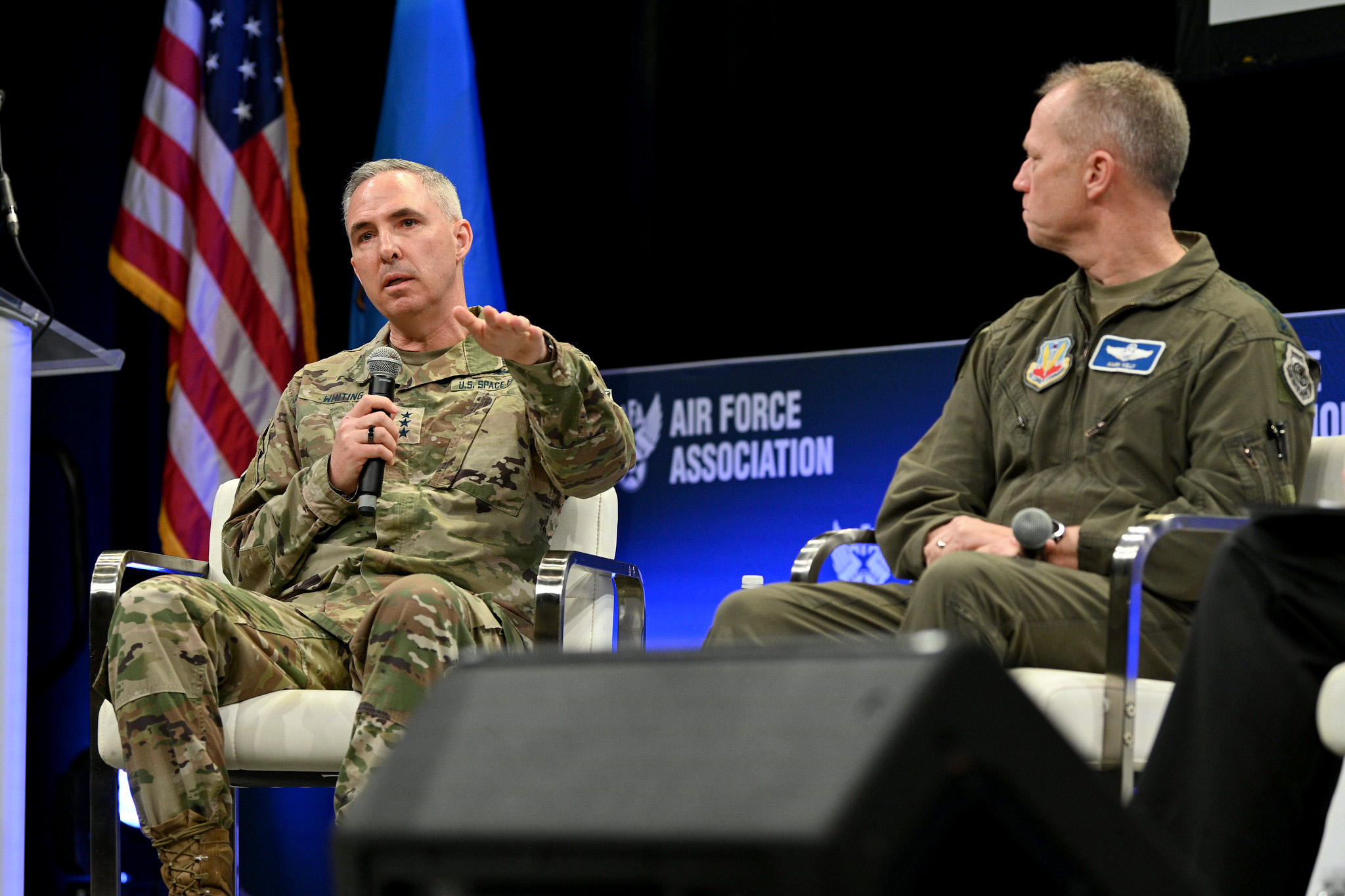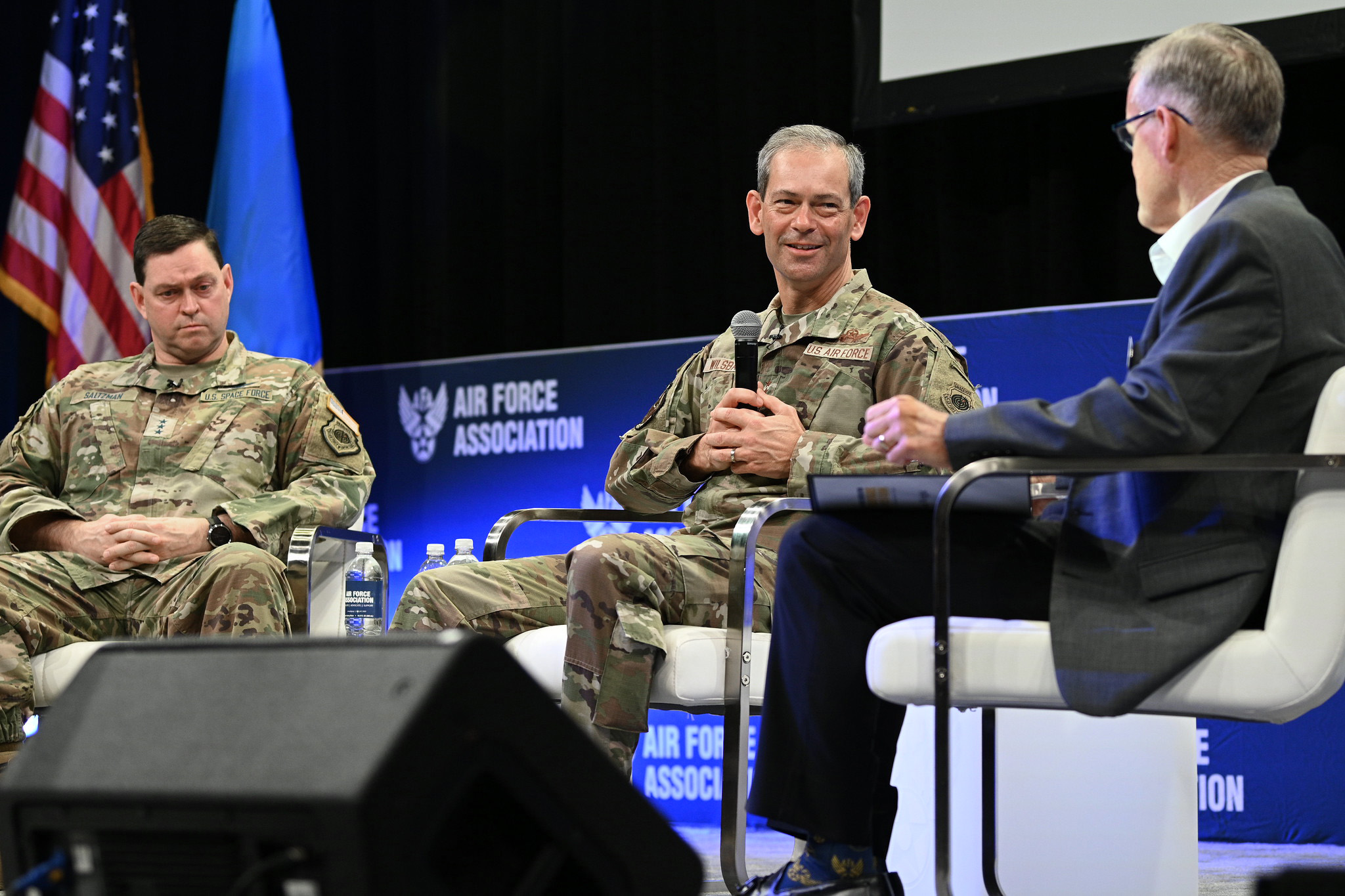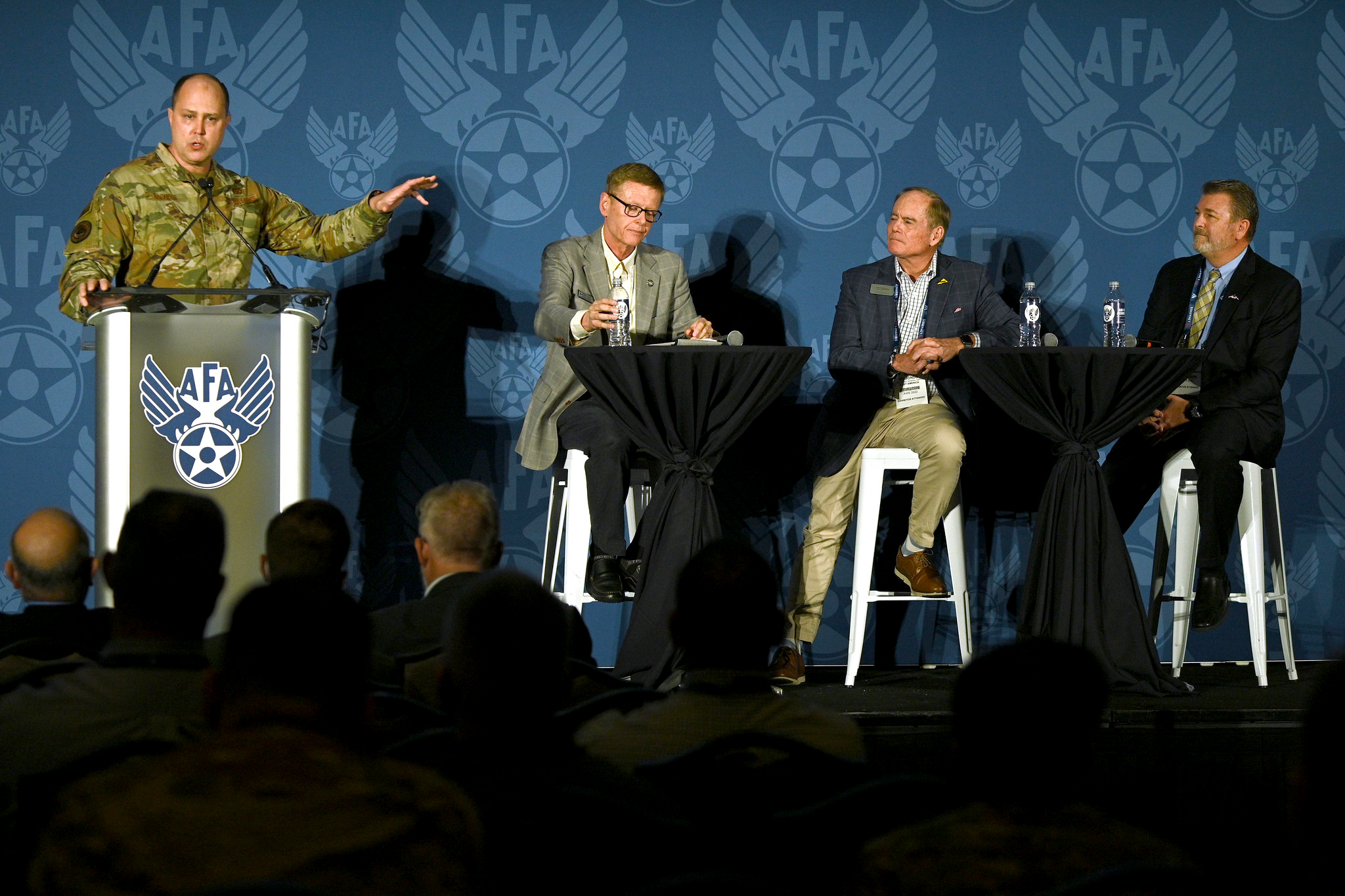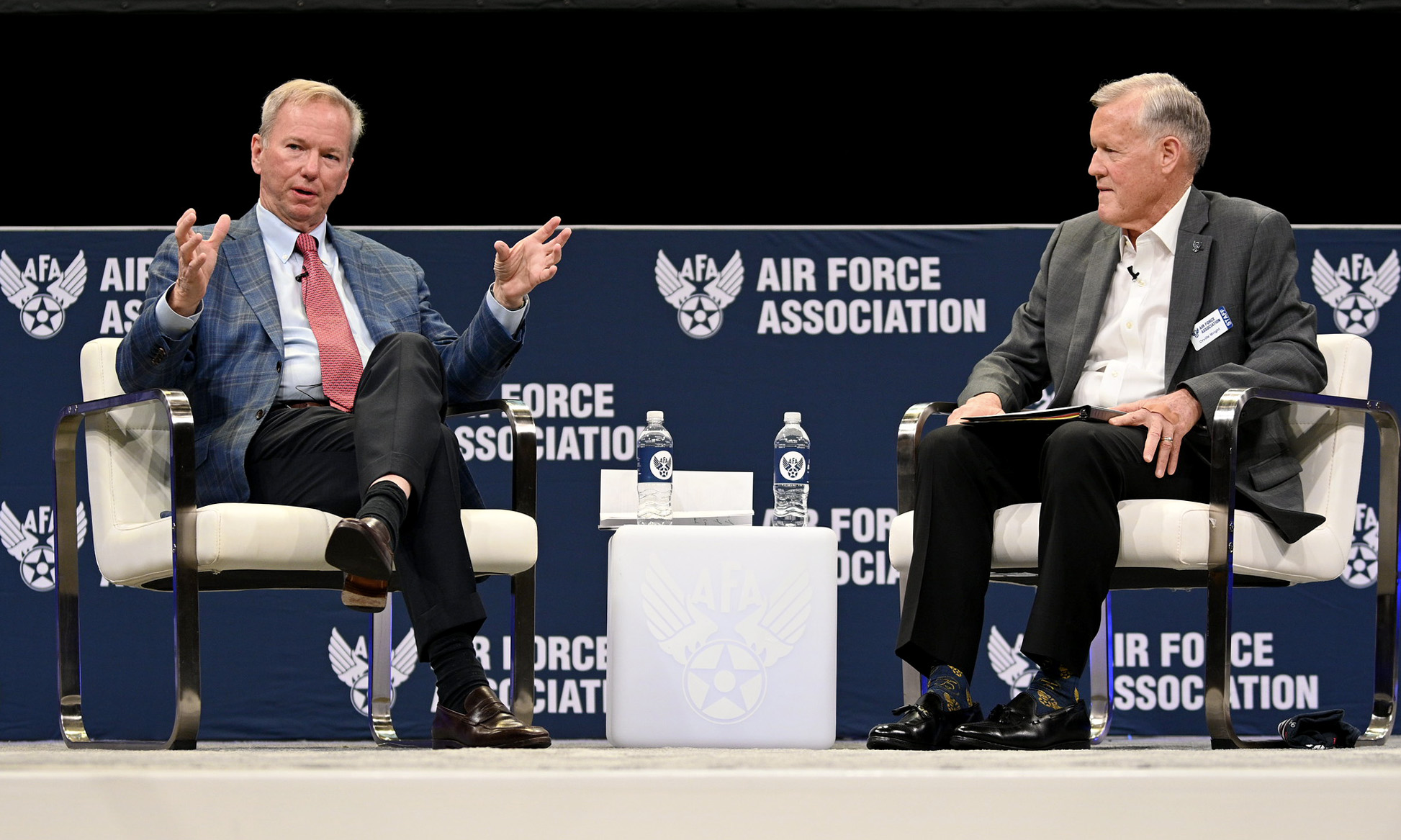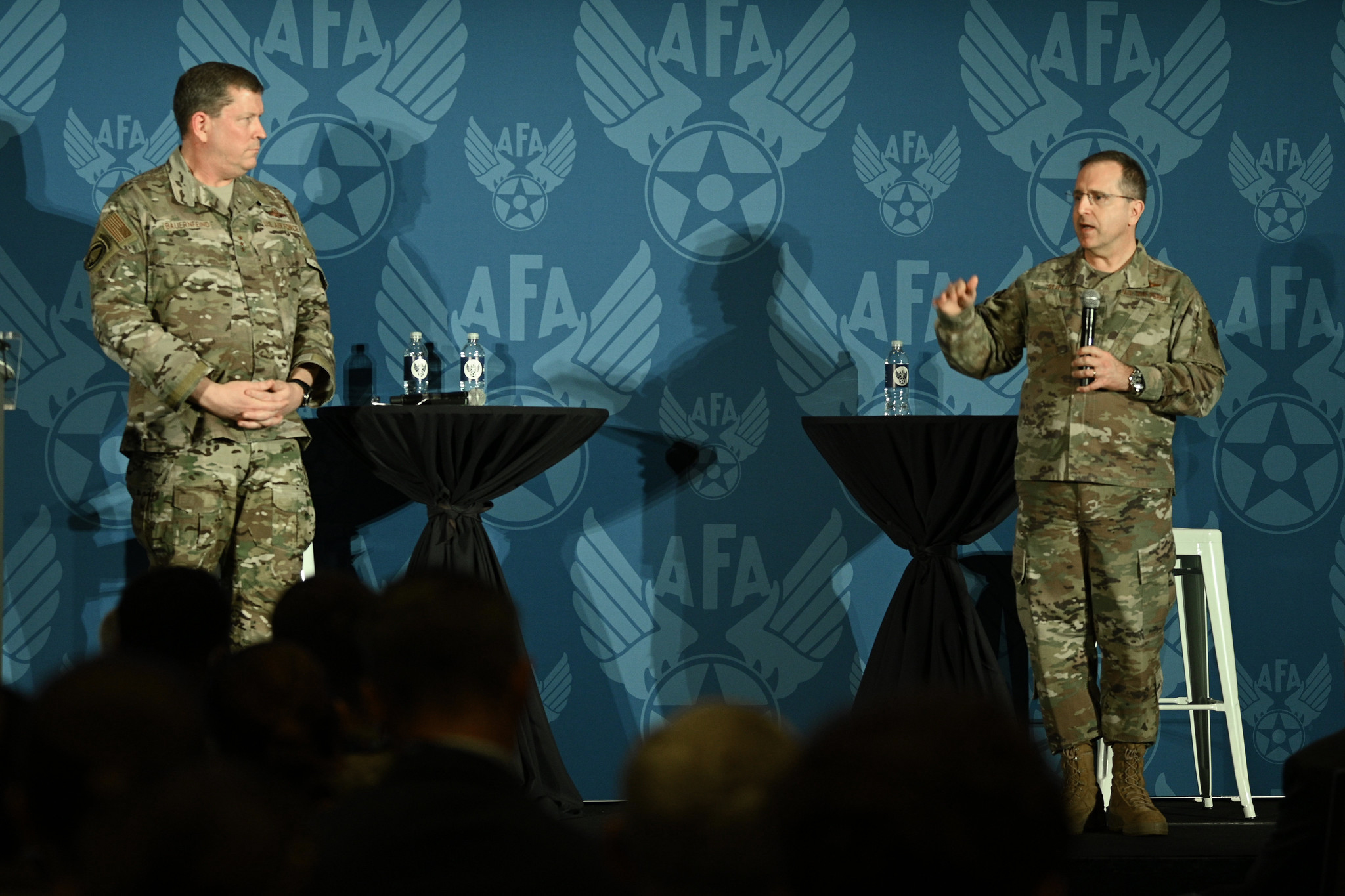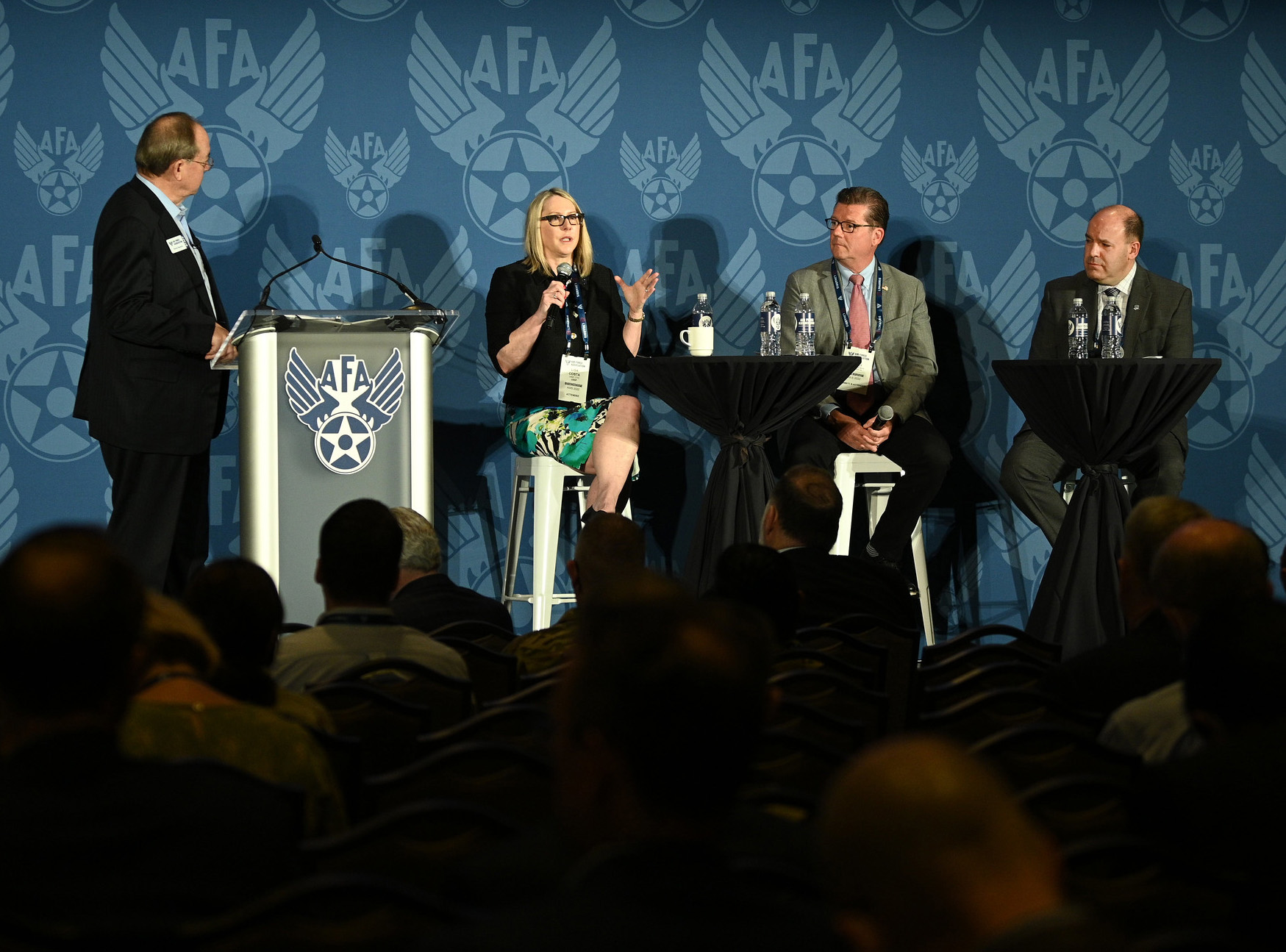Retired Air Force Gen. Lester L. Lyles moderates the panel discussion “From Warfighter Requirements to Operational Capability” with commander of Air Force Materiel Command Gen. Arnold W. Bunch Jr.; commander of Space Systems Command Space Force Lt. Gen. Michael A. Guetlein; and Randall G. Walden, director and program executive officer for the Department of the Air Force Rapid Capabilities Office during the AFA Warfare Symposium on March 4, 2022. Watch the video or read the transcript below. This transcript is made possible through the sponsorship of JobsOhio.
Overhead Voice
Ladies and gentlemen, please welcome General Lester Lyles.
Retired Gen. Lester L. Lyles
Well, there is a cheering section out there. That’s very good. For an old guy who retired 20 years ago, I didn’t think anybody would be out there, remember my name at all. Well, it is an honor to be here to moderate this excellent panel talking about a subject that many of us are very, very familiar with. And all of us, in some form or another, get a chance to live parts of this, whether it’s in the birthing, developing, operating, sustaining capabilities for our warfighters. And so the chance to have an opportunity to talk to three—just literally, the word outstanding is not strong enough—three excellent, outstanding, superior leaders in our Air Force; and particularly, that deals with providing capabilities to the warfighter. I couldn’t be more proud to have the opportunity to do this. General Arnie Bunch, of course, Air Force Materiel Command commander; General Mike Guetlein, now the Space Systems Command commander—had to think about that, Mike, just a little bit—and Mr. Waldo, Randy Walden, who we all call Waldo. And Mike, I’ll call you, Mike; and Arnie, I’ll call you Arnie If you don’t mind.
This is a very unique time for me. In so many respects, time goes by so quickly as I look out into the audience. And definitely, as I saw some of the Airmen and Guardians who are here participating in this event, I didn’t realize how many babies we have in our Air Force and Space Force today. Everybody looks so very young. Even the general officers look very young. So it’s a sort of a weird, weird time. And for this panel, one of the unique things about it for me is that, at least for two of our participants, I’ve sat in their seat in the past. Now, it was some 20 years ago when I was in the seat of Air Force Materiel Command. And I wasn’t quite in Mike’s seat, because his name and title—the organization’s changed. But I was the SMC Commander from ’94 to ’96. I know you want to look—I’m sure there’s some people who weren’t even born in ‘94—that are part of our Space Force or Air Force today. So it’s, again, an honor to have a chance to participate in this event. We don’t have a lot of time. And I want to make sure we get an opportunity for these three gentlemen to talk about what it is they’re doing in this particular area. And we hope there’ll be sort of a dialogue amongst us, if you will. I’ll have a few questions to ask and encourage the others to either add in if they want or give them a chance to make comments relative to their particular spectrum of the business that we’re in, and acquisition and requirements, etc. But first, let me just go one by one. And give us about two or three minutes just to make some comments. So and what do you think are some of your challenges and opportunities or accomplishments. So, Arnie?
Gen. Arnold W. Bunch Jr.
So General Lyles, thank you for the opportunity for—if the Airmen and the Guardians that are out there do not know who this fine gentleman is, regardless of how many years ago that he retired, you are missing a great opportunity. He has mentored and led many of us. Lieutenant Colonel Bunch learned great numbers of details from this fine gentleman, and he is a great American, has served this nation in various capacities. And no one’s going to forget the mark, the indelible mark, sir, that you’ve left on our Air and Space Force, so thank you. Thank you. Thank you. The second one that I would say initially before I go into remarks, the characterization of me as an outstanding individual, my wife would sincerely disagree with. And that’s why I spend so much of my time on the wife appeasement plan, based on the activities that I’ve done over time. So for AFA, thank you very much. Great venue, great symposium. We’ve had a lot of great dialogue. It’s an honor to be up here with these two great gentlemen who are executing the day to day J-O-B right now trying to make things happen. It’s fantastic to be up here to represent the 89,000-plus uniformed and non-uniformed Airmen that are part of Air Force Materiel Command. It’s an honor to get to work for them each and every day as they execute their wartime mission each and every day. And I often say that we’re the most important major command in the Air Force. I do not say that out of arrogance. I say that out of the fact that what we do, we do for everybody else in this room—to include a lot of things that we do for the Space Force today—but what we do for all the other major commands and for overall the Department of Defense. Since this has got to warfighter focus, I’m going to use a little bit of analogy to get a little better idea what we kind of do within Air Force Materiel Command. One of the things that my command chief Dave Flosi, my wingman, had recently happen: He had a chief master sergeant within the Air Force asked him, Why do you at Air Force Materiel Command warrant having an F-15 on a pole out in front of your headquarters? What do you have to do with any of that? And the answer was, well, we partner with industry to do the research on the materials and the engines, and the radar, and all those things that we took to try to make the airplane. We partnered with industry by procuring the assets and trying to put them in the field. We partnered with field and operational testers to do the testing. We every day sustain those still today within what we do within our depot. We were using Supply Chain Management wings to keep them flying. We did the research and the development for the weapons that they carried to be able to go execute their missions. We continue to do the modernization. We did the experimentation and the development of the uniforms and the helmets and everything else that they were. And if you take it to the extreme, we actually do the MILCON to build a runway and provide all the support structure for everybody at the base. That’s why we have an F-15 on the front of our [inaudible]. So a lot of the other things that we’re doing, I’ll wait and I’ll hit on. There is one thing, though, that I do want to talk about that as my Number One priority. And that’s diversity, equity, inclusion, and accessibility. And I had someone at Air Command and Staff College go, Secretary Kendall’s Number One priority is China, China, China. How can your Number One priority, General Bunch, be diversity, equity, inclusion, and accessibility? And the answer was actually pretty simple. I see them as very completely aligned and integrated together because our most valuable resource is our Airmen. And if I cannot create within the Air Force Materiel Command an environment where every Airman has the opportunity to perform to his or her full potential and feel valued, then we’re not going to be able to move at the speed and execute the operational imperatives to do all the other things that are critical to what we do within the command. So that’s enough for me, for the short bit, and I’ll talk more on other things. Thank you.
Gen. Michael A. Guetlein
Thank you sir. I really appreciate you hosting us today, and for AFA hosting this important dialogue. This is a little intimidating for me; all three of these gentlemen have been my mentor and are my mentors along my career all the way going back to asa captain, sir, with General Lyles. So I’m up here as the brand-new field command for Space Force. We’re about six months old, stood up last August. It is a field command in the aspect of we are equivalent to a MAJCOM but much, much smaller. So the best way to think of Space Systems Command is the AFMC of space. And whereas warfighting starts with AFMC, space starts with SSC. Why do I say that? Because every system that we buy, every system that we purchase, every capability we deliver to the nation and to the warfighter for space starts in some way, shape, or form with Space Systems Command. Space Systems Command was stood up to do basically two things. First and foremost is, to get a warfighter focus on space acquisitions. And then the second was to actually get after some of the criticisms that we’ve been receiving in space acquisitions over the past 20 years. We did that by doing a couple things. First, we stood up five new PEOs. Where SMC used to be one PEO, we are now five PEOs. Those five PEOs report directly to the service acquisition executive like you would expect all other PEOs to do.
I am not, as the commander, one of those PEOs. My job is a little bit different. My job is to organize, train, and equip. But I also have one more job under the acquisition hat, assisting the assistant secretary of the Air Force [inaudible] for system of systems integration. What do I mean by that? Over time, and one of the criticisms that we’ve had over time is that we focused a whole lot on our system-by-system capability, that we weren’t doing a really good job integrating across. Nor were we focusing on the capability that we needed to actually deliver to the warfighter. We have completely changed all that by standing up the SSC commander, the system of systems integrator, and I am now an adviser to the SAE for all milestone decisions so that we, as a department, can better integrate horizontally across the system. In addition to that, we stood up to get unity of effort. One of the criticisms that we got, and the GAO talked about a lot, was that there were 60-plus organizations that had a say in space acquisitions, and all 60 of them could say no. Standing up the Space Force was to try to get after that. And one of the ways to get after that is unity of effort. And the reason we talked about unity of effort is because we have to go across organizational boundaries, both title 10 and title 50. And we have multiple organization authorities above us that have to be somehow integrated. And they don’t all come together in one location until they come to the president of the United States. That causes [inaudible] integration challenges. So we’ve been, SSC has been, charged with trying to gain unity of effort. And we have done that through a collaborative process called the Program Integration Council, which I will talk about here in a little bit. The other reason we are a field command is because we are no longer geographically centered on Los Angeles. The Cape and Vandenberg both fall under Space Systems Command, as well as 13 other geographically separated locations to include a lieutenant colonel in Australia. We’re gonna put a lieutenant colonel in U.K. and a liaison out in PACOM to get that warfighting focus. So that in the gist is what Space Systems Command is and what we’re all about, and I’ll wait for the rest of the questions to talk a bit more about it.
Retired Gen. Lester L. Lyles
All right. Thank you, Mike. Right. Thank you. Waldo.
Randall G. Walden
Well, let me start by saying it’s great to be on this incredible panel. And also great to be on this panel with friends, very close friends. And it’s great to see so many familiar faces in the audience, all the Airmen and Guardians that I hang out with, I’ve been hanging out with for a very long time. So I’m going to start off by saying a little bit about the organization. I’d like to touch on three programs I can talk about publicly. Number one, little bit about the RCO. There was our founding fathers, a guy by the name of Dr. [Pete] Aldridge, he was the USD AT&L; Dr. Jim Roche, who was the Secretary of the Air Force at the time; and General John Jumper, who’s the chief at the time, that said, we’re frustrated. And here’s a mythbusting, not just with acquisition, but requirements process. And they wanted an organization that was some somewhat similar to the Lockheed Skunkworks. And the reason for that is they felt as though what they wanted to get done, and a high priority for them, was not getting done. And they created the Rapid Capabilities Office. And that’s been almost 20 years ago. And I’m happy to say I’ve been part of that organization, not the entire time, but for the most time. And I love it, got some of the best folks on the planet, there. A little bit of mythbusting. So all of a sudden, you get a sense of, well, how you get your stuff done is you have waivers to laws, and you have waivers to policy. That’s not true. We follow all laws and statutes. We follow all policies. Now, here’s the part that’s important and was talked about yesterday by the former CEO of Google. So what we did is we read 5000, I would not recommend that to anybody. If you’re familiar with the Defense Acquisition System, I would recommend reading the part that talks about tailoring and streamlining. We took that section, put it in a charter, and I’ve got a board of directors that are very senior leaders. And that’s how we do our business. We try to minimize bureaucracy and maximize producing capability. That’s our goal. Now three programs, briefly. So I’ll start with B-21. You may have seen the press release, talked to John Tirpak the other day on Air Force magazine. It is true, we had six bombers on the production line. We actually took one out, and we pulled it over to do the loads calibration, which is where you go over and start to bend and flex the airplane and make sure that the design that you intended to build to actually matches the predictions. And, Two, and this is the part that’s different, we actually are using the same production line that we’re going to build a minimum of 100 bombers. So we’re also verifying that the production and the manufacturing matches the predictions as well. And we’re going to learn that very shortly.
Now let’s talk a little bit about the X-37. So the X-37 we’ve been doing since April of 2010. It’s been a heavy lifter, no pun intended, of doing experimentation in space for a lot of modernization activities for space. And some might even say we were actually ahead of Space Force and helping them out as they were maturing. And it’s been really, really good. And I’ll talk about the one that’s on orbit right now. So Mission Six is currently on orbit. It’s been doing a lot of experimentation, which has been publicly released. It has 655 days on orbit. And as you know, we probably fly about two years. But once we’re done with the experimentation, and we’re ready to come back and land, we will do that. And almost two years ago, as part of a public release, we talked about the service module attached to the back end. The reason for that is, it allows us to put more experiments onboard. And so before we deorbit the X-37B we need to release that service module. And the plan right now is to do it safe and professionally in a manner that burns up in the atmosphere. That’s the plan. And that’s what we’ll do. And then we’ll recover the X-37B and refurbish it and get it ready for the next launch. Mission Seven’s coming up right after we land that one. And it will also go up with a service module. We’ll go into the details of when we’re going to launch. But suffice to say it’s not far behind when we land.
And then finally, a little bit on Advanced Battle Management System. And so there’s been a lot of conversations both in the public and on the stage this week. Just some insight, and I’m just going to offer this up right now: I could really use defense industries’ thoughts, through their lens of how we get after joint all-domain command and control. And the reason I say that is, industry works with all the services. And having that insight gives you the best lens by which you can help inform how we do ABMS and being able to meet all the service needs when it comes to sharing data. And I’m looking for everybody. And I walk the floor, every time I meet with someone, I tell them the same story: I’m looking for your thoughts and your expertise to make that real. So if I was to describe ABMS, it’s essentially really two components. The first one is you have to have an infrastructure, a digital infrastructure that allows you to, One, contain data, apply applications to that data, and share it globally. That’s the premise. And if you don’t have that infrastructure, it’s not going to work really well in sharing data. And by the way, the best part is we can leverage what commercial industry has invested in for many decades and continues to invest in, you may be familiar with it, it’s called the internet. And you probably don’t think about how those standards work, and how it all works when you log in. But you know what, that’s where we are, to leverage that expertise. And it works really well. The second part of ABMS is, OK, the capabilities. Now, we’re working on Capability Release One, which is really trying to turn the KC-46, or any other platform that can carry the pods that we’re going to go invest in. And that is being able to share data in a manner that allows not only the aircraft, whether it’s a fighter or bomber, to get replenished from fuel, whether they’re going into a fight or coming out of the fight, but also share and replenish data that they’re going to need before they go into the fight or coming out of the fight. And the thought is, if I can share that data not only with a tanker, but it goes beyond line of sight back to an air operations center, or back to strategic users, it’s incredible. It’s all the same data. It’s how you want to apply applications in a manner that allows those users, whether it’s strategic, operational or tactical, the information they need to make decisions. That’s what ABMS is about.
Retired Gen. Lester L. Lyles
Thanks, Waldo. There’s very informative. Thank you very much. Arnie, let me just ask, you know, in your previous capacity as the deputy acquisitions czar in the headquarters, you are a staunch supporter for doing things quicker and doing better. And I particularly remember a briefing you put together about faster, smarter acquisition, and the various tenets that are part of that, like supercharging the acquisition engine, creating a big ideas pipeline, and expanding industrial partnerships. So I’m just saying things that Waldo just touched upon and I know Mike is using very much in Space Systems Command. In your capacity at AFMC, have you been able to really bring those things to your trained, organized, and equipped function, or do you think you’ve actually, were able to carry through some of the things you talked about a few years ago?
Gen. Arnold W. Bunch Jr.
So, great question. And I believe we’ve got a couple of examples of things that we’re doing that definitely bring that home. If you look at what happened when we got into COVID, I got an email on a Friday night from the Vice Chief General Wilson. It said, ‘Hey, we need a means to be able—we need the transportable isolation system certified on a C-17 as quick as you can.’ All I got was an email. Three weeks later, we flew our first COVID-positive individual that went through all the certification, went through the right things that we need to do to get it out in the air. At the same time, Air Mobility Command said, ‘Hey, we need something better than that.’ We needed a negative pressure CONEX so that we can carry this. We needed to be able to go, and we need one for a C-17. We need one for a C-130 that was called light, and we need to get going. We did that, delivered it. It flew the first patient 88 days later. So when people tell you you can’t go fast, you can’t make these things happen, the reality is you can make them happen. Why was that a success? To me it was a success because there was a clear priority from all parties involved that we needed to go do this. We did not have to worry about trying to fight to get money to try to make everything align. We had the acquirers, the requirers, the medical field, the research lab, everybody, right? They’re working together with a clear sense of purpose. And when we align all of those things together, what we really do is we take the shackles off of the acquisition community, and they’re allowed to move at the speed that they need to be able to deliver those capabilities. We can’t do that in every case. But when people tell me you can’t go fast with acquisition, I point to this and go, yes, we can. What most people don’t realize is, we actually went through testing and redesigned the interior of that negative pressure CONEX in the middle of that, because it would not have survived the landings we wanted to do, the way the seats were designed. And we redesigned them within the last couple of weeks so that we would have that capability. That’s an example of going through and doing that. The other one that I believe is really successful right now is we’re moving out on our digital campaign. If you look at that and the way that we’ve got the team and AFMC focused on the assets from research all the way to retirement, we want it for test, the acquisition, the sustainment—we want all of it blended in together. GBSD has done great in that area. Working with General Cotton’s team at Global Strike Command and working with other industry partners, we went through millions of examples to find the knee and the curve for what we needed to put on contract.
Next Generation Air Dominance, it’s taking it to a whole ‘nother level in the way that we’re working with industry, the way industry is utilizing our labs and partnering with what’s going on there, all to another level for that we’re using on all platforms. The A-10 wings, we’re getting ready to get the first one done probably seven months earlier than we planned. And it’s done because we’ve done digital modeling of it. And we’re able to design it in a way that we probably wouldn’t have been able to do before. Critical for the B-52 commercial engine replacement program. We’re doing all that in a digital environment and making it happen. The other one that we started pushing on that you talked about, sir, was being innovative. We have extremely innovative Airmen. They are doing great things at the installation level. We do not have an innovation problem at the installation level where I believe we still have to do work. And we may have an innovation problem, is trying to go to scale from what we’re finding at the local levels to take it out and put it all the way across. We’ve got to find a way to move faster there so that our Airmen who are being innovative don’t lose faith that we as senior leaders are going to move out and make those things happen. And we’re going to work with people to get some money.
The last one that I will touch on is what we need with authorities. Last NDAA I was a big proponent of what I call BA-08. That is an authority that Congress gave us that gives a single program element to do coding of software. Mike is the beneficiary of that at Kobayashi Maru. Right now he’s the only program in the Department of the Air Force that gets to do that. We have three more Air Force programs that, if we can ever get the NDAA passed, will be out there. And we should be able to do them, three more of those. That is something that gets at what Dr. Schmidt talked about yesterday, about being able to move at speed, not go through the bureaucracy, put money where it needed to be put so that we can drive change and get it out into the field. We need to continue to work those things. Nothing says innovation like saying, that’s a great idea, come back in two years, and I’ll have some money and we can go. That’s what we’ve got to get extra authorities and flexibilities so that we don’t put ourselves in that position, and so that we can move at speed.
Retired Gen. Lester L. Lyles
That’s great. Thank you very much. Along those same lines there, Mike, you know, when I think back, in some respects, Space Force was created to address acquisition and for the space activities, and to do it quicker and do it better. Whether you look at SPD Space Policy Directive Number Four, which created the Space Force, or you look at your organization, you look at Frank Calvelli, who was just, I think, confirmed as the acquisitions czar for Space Force. And I look at you as a commander in your background, your unique background, your MC-130 program office, a big [inaudible] program, you’re in a B-2 program office, you’re at Missile Defense Agency, NRO, all those organizations noted for doing things fast. Are you going to be able to bring that same kind of culture to the Space Systems Command? Are there some things that perhaps scare you a little bit about trying to do that?
Gen. Michael A. Guetlein
Yes, sir. It’s a great question. When we stood up Space Systems Command to get exactly what we did, we went to Missile Defense Agency and said, how do you do business—National Reconnaissance Office, RCO Space, RCO, and even our own SMC 2.0 when we established it. I’ll tell you SSC is established on the best of the best of all those organizations. And how do I say that SSC really embraced the ACC. The SMC 2.0 really embraced the adaptive acquisition framework, which gets into what Waldo talked about tailoring. DOD 5000 allows an enormous amount of flexibility. And Secretary Lord, before she walked out, added even more flexibility. SMC 2.0 was built upon that flexibility. And we capitalized on that when we stood up SSC. You look to the Missile Defense Agency, probably the best systems integrators and the best digital engineering environment in the DOD. We capitalized on those lessons learned. You get to the National Reconnaissance Office, very flat, very empowered PEOs. We capitalized on that. Then you look at the way the Rapid Capabilities Office does business. We capitalized on all that. So that when we stood up Space Systems Command, we really did harvest what we thought was the best of the best of all the organizations to give us the agility, not only in acquisitions, to begin that system-of-systems integration approach, unity of effort, and focus on the warfighter. That’s why we are extremely flat. We just pulled another layer of leadership out with the objective of getting to the Space Force a model of no 0-6 works for an 0-6 or NH-4 equivalent. That, by doing that, pushes the authorities down and gets to what we talked a little bit about yesterday—about empowering our junior Airmen and Guardians. They are capable of an enormous amount. And they are the most innovative and the most driven individuals that I’ve ever seen. We’ve got to take the handcuffs off. And we’ve done that by trying to flatten out the organization. In addition to that, we now took what was the span of one PEO and spread that to five PEOs. That allows us to get more of a focus on the acquisitions and delivering a capability faster to the warfighter. And then integrating across them to figure out what’s the best of the breed. So in the best of the breed, we’re actually looking at our partnerships with our allies and partnerships with commercial, if I can buy it out of commercial—but buy before build, that’s what I want to do, if I can integrate with allies or take advantage of what they’ve already built. And that’s what I want to do, is integrate it. But also when I build it, I want to integrate back into their stuff. So that we are not chasing the new, next-generation thing that’s going to take us 20 more years. Instead, we’re actually integrating what we already have to get more and more capability out of the systems that have already been delivered.
Retired Gen. Lester L. Lyles
Great. Thank you. Thanks, Mike. Why don’t you—you mentioned earlier about, you don’t break any rules in terms of the authorities and all the legal requirements, etc. Yet, when I think about all the things that people are able to do, whether it’s with OTAs—other transaction authorities—the flexibility DOD 5000 does give you, and other things like a couple of ones that that Arnie mentioned, you sort of described your secret sauce of getting things done. But I keep thinking you’ve left one ingredient out that you’re not telling us about, because other people have those same authorities, but they’re not achieving the rapid capabilities that your office does. So can you tell us what that secret sauce is?
Randall G. Walden
Yes, sir. I get to brag about my organization even more. I love that. So let’s touch briefly on how we were created. I’ve already given you that insight of why we were created. Now what are we doing today. And so we are managed, governed, and overseen by a board of directors. So similar, not identical, to the way corporations work today. Why? Because the leadership wants their personal touch on what we’re doing. And so today, the board of directors we have includes undersecretary of defense for acquisition and sustainment; the undersecretary of defense for research and engineering; the Secretary of the Air Force; the Chief of Staff of the Air Force. And we added the Chief of Space Operations, because we have some space in some of the things we’re working on. And on top of that, now, the acquisition authority’s associated, so SAF/AQ is a part of that. And when the space acquisition executive is confirmed, they will become a part of our board. That’s what governs and oversees what we do. And so that’s a part of the secret sauce. Now, here’s the real secret sauce. And everybody knows this. And Arnie, you mentioned this, this is all about trying to do the right thing as fast as you can, but legally, and under the right bureaucracy that makes sense to execute the program. And I’ll tell you that that’s a culture. And that culture has got to extend from the lowest level, program managers, contracting officers, financial managers, etc. that worked for me, and we call them melting pots. We form teams—some call them program offices—we form teams, and their primary goal is to assemble this team in a manner that executes the programs. That’s how we do it. And the culture of getting things done with the least bureaucracy has to extend all the way up through to that board of directors I just introduced. Everybody’s got to have that culture. They don’t have it, then you won’t succeed. And today, I can assure you that culture exists, and it still exists. Now, don’t get me wrong, I do have to spend most of my days fighting off bureaucracy, because they want to help us. And I don’t mind doing that, for that melting pot of teams that I want to actually get those handcuffs off and let them execute. And when you empower teams with that level of expertise, it’s incredible. And I’ll just share this thought with you, I can’t remember the last time a program manager or a contracting officer has come in to me and said, ‘Hey, boss, I’ve got a great idea. You know what, we should slow the program down and increase the cost.’ They’ve never said that. And here’s the amazing part. It’s only when bureaucracy gets in the way that the schedule slips to the right and the costs start to click and creep up. And I will tell you, the more I can do to fight that bureaucracy off and let those empowered teams execute, it’s incredible. That is our secret sauce. And I’ll tell you what, I am proud to be a part of that organization and love hanging out with those individuals. They’re incredible. Thanks very much for the question.
Retired Gen. Lester L. Lyles
Waldo, that’s outstanding. And you pointed out the key, I think, component: individuals and people. The culture really translates to people in all the organizations. Let me just wax nostalgic just a little bit. When I went out to Los Angeles, as a colonel coming from Wright-Patterson Air Force Base to, uh, to run the space loss recovery program after Challenger. So we birthed Atlas, to Delta, to all those things that have now grown up to little bigger launch vehicles, if you will. But what surprised me, even though I’d been in Los Angeles as a second lieutenant, as a young rocket engineer, what surprised me was going out and finding out that the acquisition communities, space and air, they had not talked to each other. They really didn’t share best practices. I found things at Los Angeles, out at the space realm, that the aeronautics people were not doing, and vice versa, found things that they are not as committed at, that they never even heard about in the space community. So let me ask Arnie particularly, and Mike, what are you guys doing to make sure that, I know we have Guardians. Obviously, we have Airmen. What are you doing to make sure that there’s the oppos… opportunity to translate information, to share best practices, even to potentially move people so that a Guardian can become an Airman and an Airman become a Guardian? If I can, can use a term, I’d like your thoughts on how we’ve got to make sure that we don’t have stovepipes.
Gen. Arnold W. Bunch Jr.
Yes, sir. So one thing I want everybody to clearly get out of this, that I’ve got to go back to what Waldo said: We do not have anybody in mine or Mike’s organization that comes to work and says I want to go slow. OK, just so we’re really crystal clear here. We all want to get things done as quickly as we can. Some of us are just not as at the lower levels as effective at being able to get to get people to stop helping me. Which is a line that, ‘please stop helping me,’ a line that I quite frequently use. So this is a great partner right here. And we know that we’ve got things that we need to be doing together, or we’re not going to be doing the ‘One Team, One Fight’ that our secretary keep continues talking about. You know, so right now we are partners on what we’re doing in our digital campaign. When we started our digital campaign within the command roughly eight months before the bend-the-spoon presentation that happened at AFA, SMC was sitting in the room, at that time SSC. Today, we’re partnered together for how we’re going to implement this, how are we going to do it? I made a commitment roughly two years ago to Chief Raymond, that there was nothing that we were going to do in what we were doing for our digital campaign, that would preclude the Space Force from being able to tap into whatever tools we had, architectures. We had things that we were going to do together. Mike and I have continued that. We’re right now working together on how we put in packages and how we do spectrum management. That’s an area that both of us have struggled with from a process perspective. We’re working together to make sure that as I have people sitting in his monthly meetings, he has people sitting with my team and doing those very things. We are working together. We’re going to brief them on what we’re trying to do to change the way that we look at software. The software factories have grown all over the place. We need to put a little attention while they stay innovative, but we don’t have everybody competing against each other. I actually found out recently that I had three of my own organizations bid against each other to try to do some work. Industry would never do that. We’ve got to put some rules and guidelines in place so that I don’t have that happen and within my command, trying to pick up work that we would love to do, and we’re going to share those kind of lessons learned. S&T, one lab, two services, Heather Pringle’s done a great job trying to work together to make sure we’re linked. The words that I use are, Technology does not know its application until you tell it. In other words, there’s stuff that’s going on at Rome, New York, that’s predominantly funded by the Department by the Air Force side of the house, that Mike’s folks may want to use in command and control or whatever else they’re trying to do. There are things that are going on in Space Vehicles Directorate or in Sensors that would apply over, and we need to keep working that, and I think we’ve got a great relationship and how we’re doing that test. The Air Force Test Pilot School stood up a space test fundamentals class. We did that in short order. We’ve graduated quite a few Guardians, sharing those lessons learned to make sure we don’t have to go re-plow ground; and share what we’re doing from a test infrastructure place to try to keep from duplicating efforts that we don’t necessarily need to duplicate. And the last one that you hit on is extremely important. People. We have got—I know that he has Airmen that are running programs right now. I know that I have Guardians that are running part of our AFRL directorates and working in various parts of us. What he and I need to do is continue to communicate, so that we put the right Airman or the right Guardian on the right program at the right time, and not let the bureaucracy that wants to look at the eaches of what slot is it and who owns it. We’ve got to continue to work together to make sure we’re doing that collaboration and making that happen.
Retired Gen. Lester L. Lyles
Mike, your thoughts.
Gen. Michael A. Guetlein
Yes, sir. I do want to I want to start with what General Raymond said yesterday: Without a shadow of doubt, we have the best, the greatest Space Force in the entire world, built on the foundations and by the greatest Air Force in the world. And it is absolutely critical that we maintain that integration and that connectivity going forward. And General Bunch and I try to stay as connected as we can. I also integrate a lot with Waldo here to make sure that our systems and our people are aligned. I send folks—I send my best to him; he sends his best to me; and vice versa with General Bunch. All right now the way the Space Force is set up, General Bunch is our servicing MAJCOM. He makes everything go around. He provides the gate guards. He provides public affairs, contracting officers, financial officers, and a whole host of more capability that allows the Space Force to operate. So we’ve absolutely got to stay integrated.
On the lab front, the director of our [unintelligible] is co-chosen by myself and General Pringle with a dotted line to me to make sure that under the one lab-two service construct, that we stay connected. The TEO, technical executive officer works, it works on my staff and works on her staff. So we get the integration back and forth. At the lower levels, at things like RATPAC, things like GHOST, all those, we’re transferring our junior Guardians and junior Airmen back and forth. So we are working very hard to keep that technical expertise going back and forth. At the SML and ML level, we have worked very hard with the personnel folks to allow us to choose off both lists. It won’t be 100 percent one way or the other. But when I’m filling out my space SMLs and MLs, I can actually reach into the Air Force list if I need that Air Force talent, working with General Bunch and actually move that talent across. So it is absolutely critical that we stay connected and we’re working every way we can to remain connected, sir.
Retired Gen. Lester L. Lyles
Great. That’s fantastic. Thank you. We’re running a little bit short on time, so let me just ask a couple of quick questions, slightly different, if you will. We’re talking about the generation, today’s Guardians, today’s Airmen, looking at the future generation, particularly smart STEM-focused, STEM-literate people that we are going to need for Space Force, for the Air Force, for RCO, etc., etc. Are any one of you, your organizations, doing things to reach out to the school systems to begin to really make sure that people understand the value of STEM and encourage them in some way to be part of that? Not necessarily to be part of the Space Force or the Air Force or, if you will, but we’re going to need that kind of talent, and so I’m just interested if any of you are doing things to reach into the communities to really spark that.
Randall G. Walden
So the answer is yes. And so from my office it’s a little hard just to go out to the school system and start to train or try to recruit that talent, but we know it’s there. So you’ll see me every so often get in a public forum similar to this and talk about what we can do from an acquisition point of view and the engineering that we need to make sure that we can actually accomplish our job. And so we’re also creating a PhD program within the organization to allow some of those really good engineers to go get a doctorate in whatever they want to go do to include but not limited to engineering. And so we’re trying to increase a capability of the talent pool we have in the organization in a manner that helps not only us—because I want to try to hire them back after they’re done—but helps others and the greater portion of the U.S. Air Force and the U.S. Space Force. That’s our goal.
And by the way, I’ll just share this with you, last question, just briefly. So I was asked by General Raymond, when the space RCO was standing up, ‘Waldo, you got any talent out there, you know?’ And I said, ‘Yes, I do.’ And I gave him two names, the contracting officer, and the financial manager that I knew had already left, and they were out there in the talent pool. And I gave them those names. And guess what, they wanted to move to Albuquerque. So it was easy. He hired them. And oh, by the way, we populate that organization as well as other organizations to get that talent pool. And the lessons learned that they have in our, my organization spread across the map, not only to help organizations in the Department of the Air Force, but also to spread the word to that STEM. And it’s important, I’ll tell you, most of those folks go out into the world, and they spread, I think a good news. Yeah, go work in an organization that, One, empowers you. And, Two, has challenging tasks, engineering tasks. And trust me, they are hungry for that. I hope that helps.
Retired Gen. Lester L. Lyles
It does. Mike?
Gen. Michael A. Guetlein
The Space Force actually embraced it from the top with our talent market, talent management office, that’s doing a whole lot of reach out. I just signed a university partnership agreement with the University of Southern California on Thursday of last week, to partner on not only technical stuff, but also on Space Policy. We’re also doing some things with California Polytechnic, with Congressman Carbajal. So we have an enormous amount of reach out that that starts all the way at grade school level all the way into our PhD programs.
Retired Gen. Lester L. Lyles
Great, thank you. And by the way, your university partnership program, I think General Raymond was going out to my alma mater, Howard University, in April to formally make them part of the UPP program. I’m very, very happy to hear that. Arnie.
Gen. Arnold W. Bunch Jr.
Sir, we do have STEM programming—I know we’re running out of time. We do have an active STEM program trying to reach out, getting into schools. I’m doing, I did the video for the LEGO competition in Ohio, that they’re going to show for the junior and the more senior LEGOs, so that we’ve got a face out there letting them know and trying to encourage them to do this. The other thing I think is really important, we’ve done under General Pringle, and Dr. Welsh, we’ve really expanded out the partnerships that we’re doing with a lot of universities, and you see the benefits of that when you bring them in as interns. That’s a little later than what you asked, but you also need to get some of these PhDs and others who are ginormous brains—you’re worried about whether they’re going to tip over because their brains are so big—and you need to bring them in. So I was just recently at one of the directorates. And it was a Dr. [inaudible], and she was there. And she was explaining to me how on the end of the nose, she was designing the materials so the nose could turn, and we could more actively respond and be able to take out weapons along the way. She had never heard of the Air Force. She had no idea what we did. She came and did an internship. She is now in her second or third year. Talking to her was so motivating and inspiring for me that it was beyond belief. We just have to expose them to the great things that they’re doing in any one of these organizations. And we can move out.
Retired Gen. Lester L. Lyles
Great, fantastic. Well, we’ve run out of time for this panel discussion. I tell you, I could talk about this all day. And I’m sure you guys could too. So I wish we had more time to delve into some of the topics and subjects. It really is broad and I can’t think of three better leaders to talk about and to not just talk about it, but to actually enact and make sure we’re doing the right things for our United States Air Force and United States Space Force. So please join me in a round of applause for our three panel members.

